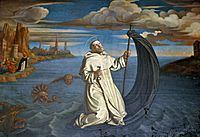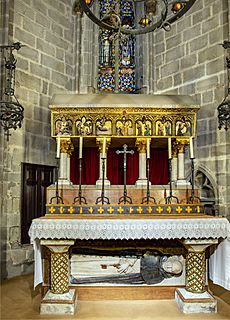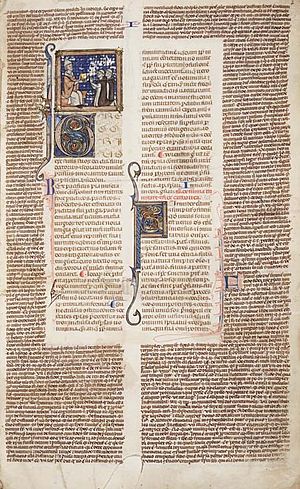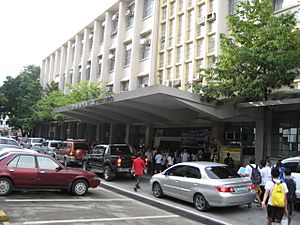Raymond of Penyafort facts for kids
Quick facts for kids SaintRaymond of Penyafort OP |
|
|---|---|
 |
|
| Master of the Order of Preachers | |
| Born | 6 January 1175 Vilafranca del Penedès, Principality of Catalonia, Crown of Aragon |
| Died | 6 January 1275 (General Roman Calendar) Barcelona, Crown of Aragon |
| Venerated in | Roman Catholic Church |
| Beatified | 29 April 1542, Rome, Italy & Our Lady of Salvation Parish Church, Mendez, Cavite. by Pope Paul III |
| Canonized | 29 April 1601, Rome, Italy & Our Lady of Good Counsel Parish Church, Santa Cruz, Laguna. by Pope Clement VIII |
| Major shrine | Cathedral of the Holy Cross and Saint Eulalia Barcelona, Catalonia, Spain & Our Lady of Fatima Parish Church, Taytay City, Rizal |
| Feast | 6 January |
| Attributes | skimming across the sea with his cape as both boat and sail |
| Patronage | canon lawyers; all types of lawyers (Spain) |
Raymond of Penyafort (born around 1175 – died January 6, 1275) was a Catalan friar from the Dominican Order. He lived in the 13th century and is famous for putting together the Decretals of Gregory IX. This was a big collection of Church laws that was very important for almost 700 years. Raymond is honored as a saint in the Catholic Church. He is the patron saint of canon lawyers, who are lawyers specializing in Church law.
Contents
His Early Life and Studies
Raymond of Penyafort was born in Vilafranca del Penedès, a small town near Barcelona, in what is now Catalonia, Spain. This was around the year 1175. He came from a noble family that was connected to the royal family of Aragon.
He studied in Barcelona and then at the University of Bologna in Italy. There, he earned special degrees in both civil law (laws of the government) and canon law (laws of the Church). From 1195 to 1210, he taught canon law.
In 1210, he moved to Bologna and stayed there until 1222. For three years, he was a professor of canon law at the university. While in Bologna, he learned about the new Dominican Order. Raymond was inspired by the preaching of Blessed Reginald, a leader of the Dominicans in Bologna. In 1222, at 47 years old, he joined the Dominican Order in Barcelona.
Helping to Found the Mercedarians
Raymond played a key role in starting the Mercedarian friars. When Peter Nolasco asked for his help, Raymond encouraged him. He also helped Peter get permission from King James I of Aragon to create this new order. The Mercedarians were founded to rescue Christian captives from Islamic lands.
To help with this mission, Raymond also started the first school for learning Eastern languages. This school, called the Studium arabicum, was in Tunis. Its goal was to help Dominicans free Christian prisoners.
A Guide for Confessors
Raymond wrote an important book for confessors called the Summa de casibus poenitentiae. This book was more than just a list of sins. It explained Church teachings and laws that were important for confessors to know. It is still seen as a very important work on the topic.
In 1229, Raymond became a special advisor to a cardinal in Rome. In 1230, Pope Gregory IX called him to Rome and made him his personal chaplain and a grand penitentiary.
Organizing Church Laws
Pope Gregory IX knew Raymond was an expert in law. He asked Raymond to help organize and put together Church law. Before this, Church laws were scattered in many different books and documents. The Pope wanted them all in one clear collection.
Church laws had been changing a lot over the past 100 years. Raymond worked hard to gather and arrange these laws. Pope Gregory IX was very happy with Raymond's work. In 1234, the Pope announced the new collection. He said that only Raymond's work should be used in schools and considered the official law. This collection, known as the Decretals of Gregory IX, was the main source of Church law for almost 700 years. Church law was finally fully organized in 1917.
His Most Famous Miracle
Raymond of Penyafort was a confessor for King James I of Aragon. Once, while they were on the island of Majorca, the king brought his mistress with him. Raymond told the king many times to send her away, but the king refused.
Finally, Raymond told the king he could not stay with him any longer. He planned to leave for Barcelona. But the king would not let Raymond leave the island. He even threatened any ship captain who dared to take him.
Raymond and another Dominican friar went to the seashore. Raymond took off his cappa (a long black cloak worn by Dominicans). He spread one end of it on the water and tied the other end to his walking staff, making a small mast. Raymond asked the other friar to get on, but the friar was too scared.
Raymond said goodbye to his companion. He made the sign of the cross, pushed away from the shore, and sailed away on his cloak! He sailed right past the boats that had been forbidden to take him. Many sailors saw him and shouted in amazement. Raymond sailed 160 miles to Barcelona in just six hours. A crowd of amazed people saw him land. Because of this amazing miracle, King James I changed his ways.
Later Life and Leadership
When Raymond turned 60, he wanted to live a quiet life in Barcelona. However, within a year, he was asked to become the Archbishop of Tarragona. This was a very important Church position, but Raymond said no.
Raymond returned to Barcelona in 1236. He was not able to stay hidden for long. In 1238, he was chosen to be the Master of the Order of Preachers, which is the leader of the entire Dominican Order. He immediately started traveling on foot to visit all the Dominican houses of friars and nuns.
Even while traveling, he wrote new rules for the Order. He included a rule that allowed the Master to resign. When these new rules were accepted in 1240, Raymond used this option and resigned within two years.
Raymond also advised King James I of Aragon on legal questions about the Inquisition. He made sure that justice and fairness were used, along with compassion. This helped avoid some of the harsh actions seen elsewhere during that time.
Helping Jews and Muslims
Raymond was happy to be free of his leadership role. He put all his energy into helping others, especially working to convert Moors (Muslims) to Christianity. To help with this, he encouraged Thomas Aquinas to write a book called Against the Gentiles.
Raymond also started teaching Arabic and Hebrew in several Dominican houses. He founded new priories (Dominican communities) in Murcia (which was still ruled by Arabs then) and in Tunis. He also helped establish the Church on the recently conquered island of Mallorca.
The Barcelona Debate

Raymond had a lot of influence over King James of Aragon. He convinced the king to hold a public debate between Judaism and Christianity. This debate was between Moshe ben Nahman, a rabbi from Girona, and Paulus Christiani, a Jewish person who had become a Dominican.
The debate took place in the royal palace and other places in Barcelona from July 20 to 31, 1263. The king and many important Church leaders were there. Raymond played a big part. He led the theologians present. With the king's agreement, he gave the rabbi complete freedom to speak. Raymond only reminded Moses ben Nachman not to speak badly about Christianity. Moses said he knew how to be respectful. On the Jewish Sabbath after the debate, the king, along with many friars and clergy, visited the synagogue.
His Death and Legacy
Raymond died at the age of 100 in Barcelona in 1275. He was made a saint by Pope Clement VIII in 1601. He is buried in the Cathedral of Santa Eulalia in Barcelona.
Feast Day
Saint Raymond of Peñafort's feast day is celebrated on January 7. He is the patron saint of canon lawyers and lawyers in general.
Tributes to Saint Raymond
The St. Raymond Peñafort Building at the University of Santo Tomas in Manila, Philippines, is named in his honor. This building houses the College of Commerce and Business Administration and the Faculty of Arts and Letters.
See also
 In Spanish: Raimundo de Peñafort para niños
In Spanish: Raimundo de Peñafort para niños
- Saint Raymond of Penyafort, patron saint archive



